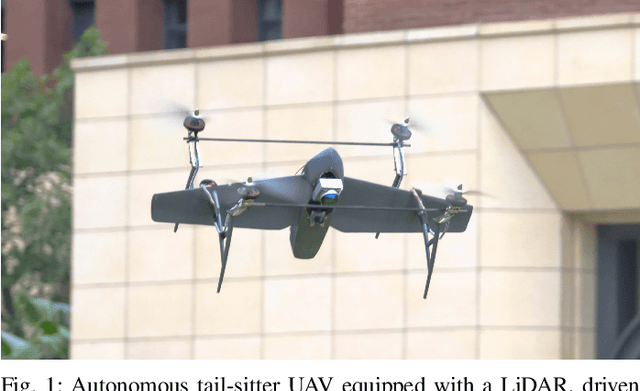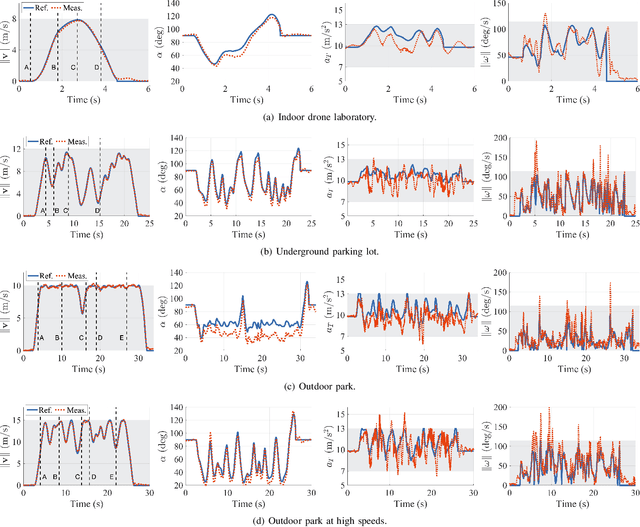Ximin Lyu
Aerial Grasping via Maximizing Delta-Arm Workspace Utilization
Jun 18, 2025Abstract:The workspace limits the operational capabilities and range of motion for the systems with robotic arms. Maximizing workspace utilization has the potential to provide more optimal solutions for aerial manipulation tasks, increasing the system's flexibility and operational efficiency. In this paper, we introduce a novel planning framework for aerial grasping that maximizes workspace utilization. We formulate an optimization problem to optimize the aerial manipulator's trajectory, incorporating task constraints to achieve efficient manipulation. To address the challenge of incorporating the delta arm's non-convex workspace into optimization constraints, we leverage a Multilayer Perceptron (MLP) to map position points to feasibility probabilities.Furthermore, we employ Reversible Residual Networks (RevNet) to approximate the complex forward kinematics of the delta arm, utilizing efficient model gradients to eliminate workspace constraints. We validate our methods in simulations and real-world experiments to demonstrate their effectiveness.
IRS: Instance-Level 3D Scene Graphs via Room Prior Guided LiDAR-Camera Fusion
Jun 07, 2025Abstract:Indoor scene understanding remains a fundamental challenge in robotics, with direct implications for downstream tasks such as navigation and manipulation. Traditional approaches often rely on closed-set recognition or loop closure, limiting their adaptability in open-world environments. With the advent of visual foundation models (VFMs), open-vocabulary recognition and natural language querying have become feasible, unlocking new possibilities for 3D scene graph construction. In this paper, we propose a robust and efficient framework for instance-level 3D scene graph construction via LiDAR-camera fusion. Leveraging LiDAR's wide field of view (FOV) and long-range sensing capabilities, we rapidly acquire room-level geometric priors. Multi-level VFMs are employed to improve the accuracy and consistency of semantic extraction. During instance fusion, room-based segmentation enables parallel processing, while the integration of geometric and semantic cues significantly enhances fusion accuracy and robustness. Compared to state-of-the-art methods, our approach achieves up to an order-of-magnitude improvement in construction speed while maintaining high semantic precision. Extensive experiments in both simulated and real-world environments validate the effectiveness of our approach. We further demonstrate its practical value through a language-guided semantic navigation task, highlighting its potential for real-world robotic applications.
Autonomous Flights inside Narrow Tunnels
May 26, 2025



Abstract:Multirotors are usually desired to enter confined narrow tunnels that are barely accessible to humans in various applications including inspection, search and rescue, and so on. This task is extremely challenging since the lack of geometric features and illuminations, together with the limited field of view, cause problems in perception; the restricted space and significant ego airflow disturbances induce control issues. This paper introduces an autonomous aerial system designed for navigation through tunnels as narrow as 0.5 m in diameter. The real-time and online system includes a virtual omni-directional perception module tailored for the mission and a novel motion planner that incorporates perception and ego airflow disturbance factors modeled using camera projections and computational fluid dynamics analyses, respectively. Extensive flight experiments on a custom-designed quadrotor are conducted in multiple realistic narrow tunnels to validate the superior performance of the system, even over human pilots, proving its potential for real applications. Additionally, a deployment pipeline on other multirotor platforms is outlined and open-source packages are provided for future developments.
FERMI: Flexible Radio Mapping with a Hybrid Propagation Model and Scalable Autonomous Data Collection
Apr 21, 2025Abstract:Communication is fundamental for multi-robot collaboration, with accurate radio mapping playing a crucial role in predicting signal strength between robots. However, modeling radio signal propagation in large and occluded environments is challenging due to complex interactions between signals and obstacles. Existing methods face two key limitations: they struggle to predict signal strength for transmitter-receiver pairs not present in the training set, while also requiring extensive manual data collection for modeling, making them impractical for large, obstacle-rich scenarios. To overcome these limitations, we propose FERMI, a flexible radio mapping framework. FERMI combines physics-based modeling of direct signal paths with a neural network to capture environmental interactions with radio signals. This hybrid model learns radio signal propagation more efficiently, requiring only sparse training data. Additionally, FERMI introduces a scalable planning method for autonomous data collection using a multi-robot team. By increasing parallelism in data collection and minimizing robot travel costs between regions, overall data collection efficiency is significantly improved. Experiments in both simulation and real-world scenarios demonstrate that FERMI enables accurate signal prediction and generalizes well to unseen positions in complex environments. It also supports fully autonomous data collection and scales to different team sizes, offering a flexible solution for creating radio maps. Our code is open-sourced at https://github.com/ymLuo1214/Flexible-Radio-Mapping.
Predictor-Based Time Delay Control of A Hex-Jet Unmanned Aerial Vehicle
Mar 12, 2025Abstract:Turbojet-powered VTOL UAVs have garnered increased attention in heavy-load transport and emergency services, due to their superior power density and thrust-to-weight ratio compared to existing electronic propulsion systems. The main challenge with jet-powered UAVs lies in the complexity of thrust vectoring mechanical systems, which aim to mitigate the slow dynamics of the turbojet. In this letter, we introduce a novel turbojet-powered UAV platform named Hex-Jet. Our concept integrates thrust vectoring and differential thrust for comprehensive attitude control. This approach notably simplifies the thrust vectoring mechanism. We utilize a predictor-based time delay control method based on the frequency domain model in our Hex-Jet controller design to mitigate the delay in roll attitude control caused by turbojet dynamics. Our comparative studies provide valuable insights for the UAV community, and flight tests on the scaled prototype demonstrate the successful implementation and verification of the proposed predictor-based time delay control technique.
Whole-Body Integrated Motion Planning for Aerial Manipulators
Jan 11, 2025Abstract:Efficient motion planning for Aerial Manipulators (AMs) is essential for tackling complex manipulation tasks, yet achieving coupled trajectory planning remains challenging. In this work, we propose, to the best of our knowledge, the first whole-body integrated motion planning framework for aerial manipulators, which is facilitated by an improved Safe Flight Corridor (SFC) generation strategy and high-dimensional collision-free trajectory planning. In particular, we formulate an optimization problem to generate feasible trajectories for both the quadrotor and manipulator while ensuring collision avoidance, dynamic feasibility, kinematic feasibility, and waypoint constraints. To achieve collision avoidance, we introduce a variable geometry approximation method, which dynamically models the changing collision volume induced by different manipulator configurations. Moreover, waypoint constraints in our framework are defined in $\mathrm{SE(3)\times\mathbb{R}^3}$, allowing the aerial manipulator to traverse specified positions while maintaining desired attitudes and end-effector states. The effectiveness of our framework is validated through comprehensive simulations and real-world experiments across various environments.
NDOB-Based Control of a UAV with Delta-Arm Considering Manipulator Dynamics
Jan 10, 2025Abstract:Aerial Manipulators (AMs) provide a versatile platform for various applications, including 3D printing, architecture, and aerial grasping missions. However, their operational speed is often sacrificed to uphold precision. Existing control strategies for AMs often regard the manipulator as a disturbance and employ robust control methods to mitigate its influence. This research focuses on elevating the precision of the end-effector and enhancing the agility of aerial manipulator movements. We present a composite control scheme to address these challenges. Initially, a Nonlinear Disturbance Observer (NDOB) is utilized to compensate for internal coupling effects and external disturbances. Subsequently, manipulator dynamics are processed through a high pass filter to facilitate agile movements. By integrating the proposed control method into a fully autonomous delta-arm-based AM system, we substantiate the controller's efficacy through extensive real-world experiments. The outcomes illustrate that the end-effector can achieve accuracy at the millimeter level.
Autonomous Tail-Sitter Flights in Unknown Environments
Nov 26, 2024



Abstract:Trajectory generation for fully autonomous flights of tail-sitter unmanned aerial vehicles (UAVs) presents substantial challenges due to their highly nonlinear aerodynamics. In this paper, we introduce, to the best of our knowledge, the world's first fully autonomous tail-sitter UAV capable of high-speed navigation in unknown, cluttered environments. The UAV autonomy is enabled by cutting-edge technologies including LiDAR-based sensing, differential-flatness-based trajectory planning and control with purely onboard computation. In particular, we propose an optimization-based tail-sitter trajectory planning framework that generates high-speed, collision-free, and dynamically-feasible trajectories. To efficiently and reliably solve this nonlinear, constrained \textcolor{black}{problem}, we develop an efficient feasibility-assured solver, EFOPT, tailored for the online planning of tail-sitter UAVs. We conduct extensive simulation studies to benchmark EFOPT's superiority in planning tasks against conventional NLP solvers. We also demonstrate exhaustive experiments of aggressive autonomous flights with speeds up to 15m/s in various real-world environments, including indoor laboratories, underground parking lots, and outdoor parks. A video demonstration is available at https://youtu.be/OvqhlB2h3k8, and the EFOPT solver is open-sourced at https://github.com/hku-mars/EFOPT.
DOB-based Wind Estimation of A UAV Using Its Onboard Sensor
Sep 03, 2024Abstract:Unmanned Aerial Vehicles (UAVs) play a crucial role in meteorological research, particularly in environmental wind field measurements. However, several challenges exist in current wind measurement methods using UAVs that need to be addressed. Firstly, the accuracy of measurement is low, and the measurement range is limited. Secondly, the algorithms employed lack robustness and adaptability across different UAV platforms. Thirdly, there are limited approaches available for wind estimation during dynamic flight. Finally, while horizontal plane measurements are feasible, vertical direction estimation is often missing. To tackle these challenges, we present and implement a comprehensive wind estimation algorithm. Our algorithm offers several key features, including the capability to estimate the 3-D wind vector, enabling wind estimation even during dynamic flight of the UAV. Furthermore, our algorithm exhibits adaptability across various UAV platforms. Experimental results in the wind tunnel validate the effectiveness of our algorithm, showcasing improvements such as wind speed accuracy of $0.11$ m/s and wind direction errors of less than $2.8^\circ$. Additionally, our approach extends the measurement range to $10$ m/s.
DIABLO: A 6-DoF Wheeled Bipedal Robot Composed Entirely of Direct-Drive Joints
Aug 01, 2024Abstract:Wheeled bipedal robots offer the advantages of both wheeled and legged robots, combining the ability to traverse a wide range of terrains and environments with high efficiency. However, the conventional approach in existing wheeled bipedal robots involves motor-driven joints with high-ratio gearboxes. While this approach provides specific benefits, it also presents several challenges, including increased mechanical complexity, efficiency losses, noise, vibrations, and higher maintenance and lubrication requirements. Addressing the aforementioned concerns, we developed a direct-drive wheeled bipedal robot called DIABLO, which eliminates the use of gearboxes entirely. Our robotic system is simplified as a second-order inverted pendulum, and we have designed an LQR-based balance controller to ensure stability. Additionally, we implemented comprehensive motion controller, including yaw, split-angle, height, and roll controllers. Through expriments in simulations and real-world prototype, we have demonstrated that our platform achieves satisfactory performance.
 Add to Chrome
Add to Chrome Add to Firefox
Add to Firefox Add to Edge
Add to Edge